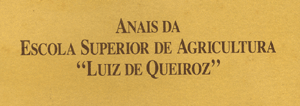In a Dark Red Latosol, sandy phase, with 0.3 ppm of "available" Zn (Mehlich), the effectiveness of three zinc sources (sulphate, oxide, and fritted-FTE BR-12) was studied in the greenhouse, using corn as a test plant. The following leves of the micronutrient were used: sulphate - 0.0, 0.5, 1.0 and 1.5 ppm, oxide and FTE BR-12 - 1.0 ppm. It was found that the test plant reacted differently to the three sources: sulphate beyond the 1.0 ppm level of supply induced toxicity; although equally efficient in terms of dry matter production, the two insoluble sources did no restrict growth when supplied at the same rate There was a highly significant correlation between Zn applied and taken up. Both DTPA-TEA and Mehlich's solution estimated equally well residual Zn in the soil. The two insoluble sources left in the soil a content of available Zn roughly equal to that found in the intermediate level of sulphate addition. Attention should be drawn to the risk of inducing zinc toxicity when soluble sources are used in sandy soils similar to that employed in the present experiment.
